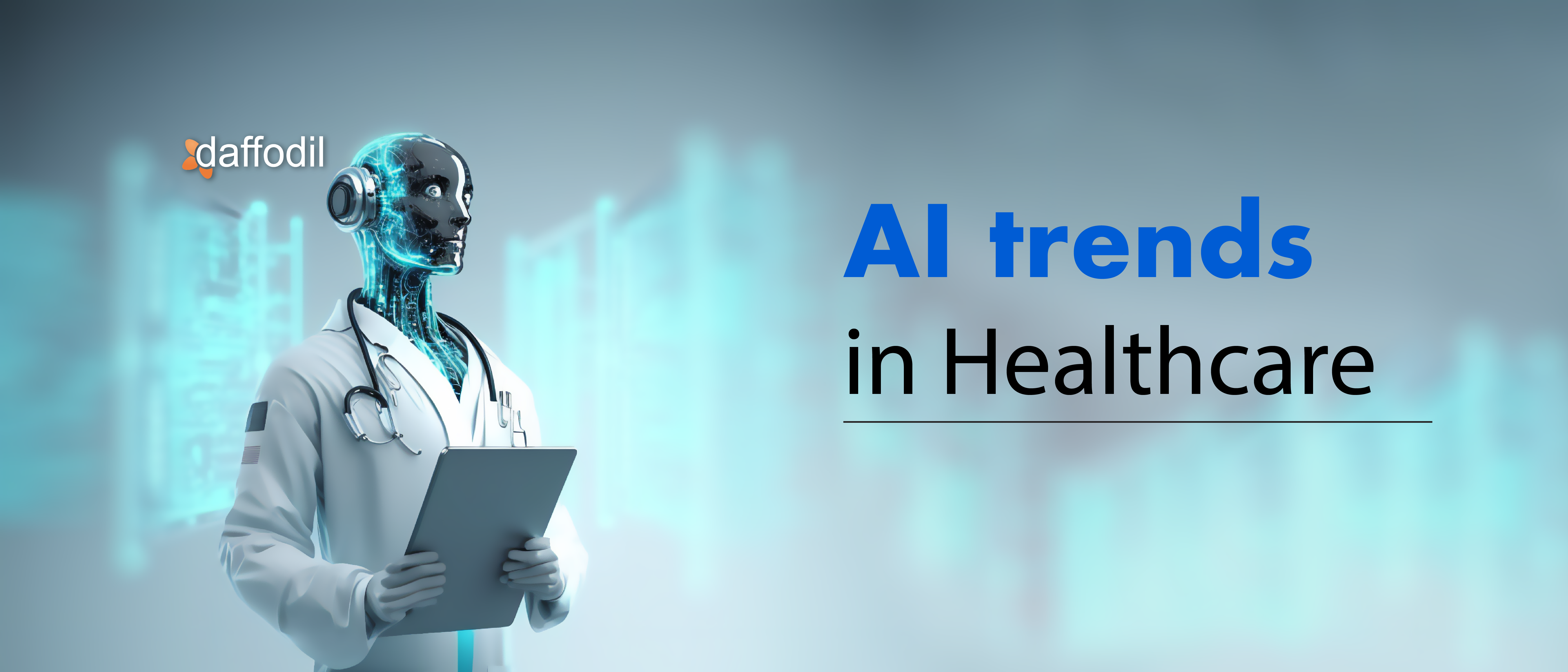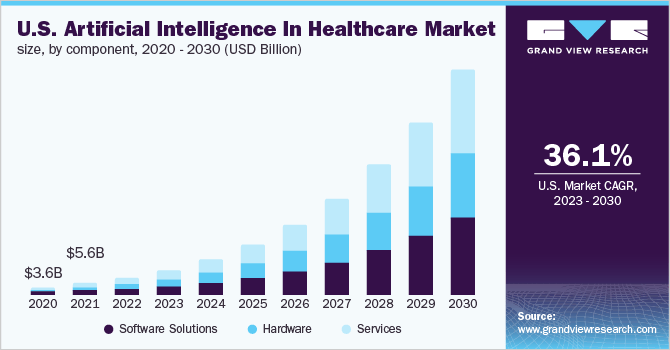
To me, nothing seems more fascinating than the fact that machine, a manifestation of human knowledge, could be developed to such an extent that it is able to be on par with human. Be it self-driving vehicles, the infamous Chess match or Google's Alpha Go, technology is giving end-to-end competition to humans. With the rapid advancement of technology and automation, there is rarely a field left untouched by machines. One such field is the healthcare industry.
More and more people are becoming concerned about their health every day. Even the consumer trend shows that society is becoming health conscious. With people joining gym classes, jogging, or even an early morning walk in the park, they all are concerned about their health. Why shouldn’t they be, after all, health is one of the most important aspects in one’s life.
But what if someone gets sick and needs treatment? Solution? Let's go to the hospital or consult a doctor. But, there is no denying the fact that there is a shortage of good doctors. Even, searching for the term ‘lack of doctors’ on Google shows the various reports, in different countries. According to a report, 27% of deaths in India and 32% of the deaths worldwide were due to lack of access to surgery or anesthesia. No one should suffer or be inaccessible to treatment just because either there are too many patients or there are too less doctors. We need a system to automate various processes as well as a system to help in decision-making. Hence the AI.

How does AI Help?
1. Chatbots
(Scenario 1)
Imagine yourself having a headache. The first question that comes to my mind is “Why am I having a headache”? Is it because sitting in front of your laptop’s screen for too long?
Or maybe you heard one of Justin Bieber’s songs. We probably will sleep over it and hope the headache is gone by the time we wake up. What if your headache is also accompanied by a high fever? We will probably take a medicine advised by some family member, or friend, or the medicine you have been taking whenever this situation arises, and hope health goes back to normal tomorrow. The point is, there is no system that will recommend you what action should you choose based on your own personal condition. Hence the chatbots.
(Scenario 2)
There are a lot of situations where a patient just needs advice or assistance regarding his problem, rather than full medical care. In many cases, people tend to rush to the doctor out of their nervousness, and confusion on even catching a cold while some people choose to ignore symptoms that may be of a serious health disease. The Internet is a good source of information but it’s difficult to find a good and reliable source. Plus people generally don’t find advice specific to their conditions based on their past and present facts. Personal Assistants will be able to provide users with information regarding what he/she should do, based on the questions asked, thus saving a lot of time and guiding users as to what action he/she should choose next.
Chatbots are capable of suggesting you with solutions to your problem, based on the questions asked during the conversation. They can be implemented using Long short-term memory cells. LSTM is a type of recurrent neural network which is capable of learning long-term dependency. This ‘long term dependency’ here refers to the fact that the bot is able to answer your questions based on previous conversations.
2. Design Treatment Plans
There is no end to the amount of medical records, papers, and history available if one wishes to discover. This data, often referred to as “Big Data” can be utilized in order to design a treatment plan by identifying the type of problem and its solution. Based on the patient’s details, it is able to detect the disease and even suggest a solution for it. For example, Google’s Deepmind Project mines the patient’s data for providing better treatment to them.
We can implement a similar system using Deep learning, where multiple hidden layers are used in order to find patterns between stored medical databases and patients’ medical records and provide suggestions based on it. Google shares a research paper where it designs a system to detect Diabetic eye disease.
3. Drug Discovery
Guess what is the time and money required to develop a new pharmaceutical drug? It’s 12 years and $2.6 billion. What if all this huge amount of time and money could be shortened using your machines instead of test tubes? Deep learning can also be implemented in order to develop new drugs or to provide labs with an environment for their testing. For example, Atomwise uses AI to accelerate drug discovery for diseases like Ebola, multiple sclerosis, and leukemia.
READ MORE: Top 7 Applications of AI in Healthcare
4. Robots
Whenever someone discusses the term AI, most people visualize it with robots. Though AI is a much broader concept than that, robots also find multiple applications in the healthcare industry.
- In Belgian Hospitals, robots are used to greet people as well as react based on emotions. It could also be used as a support tool in the pediatric and geriatric departments.
- Therapeutic robots provide assistance for patients to improve their quality of life, reducing the social service required.
- Robotic Surgery assists doctors to treat patients with precision, decreased blood loss, less pain, etc. It also ascertains quicker healing as compared to traditional methods. It removes the possibility of tissue trauma, as well as provides doctors with opportunity for remote surgery.
- Germ-Zapping Robots are being used to disinfect rooms, reducing deaths due to hospital-acquired infections.
5. AI Health Coach
AI health coaches are like personal assistants that use cutting-edge technology to provide individualized health advice and support. They help people achieve their health goals by giving guidance on nutrition, fitness, and medication management. You can interact with them through chatbots, voice assistants, or mobile apps, and they're pretty smart in understanding your needs!
News has surfaced about Apple's efforts in creating an AI-based health coach designed to assist users with exercise, sleep, and eating improvements. This upcoming service will collect user data and analyze it using smart algorithms to offer practical insights. Additionally, Apple is working on incorporating a non-invasive method for blood glucose monitoring, eliminating the need for drawing blood.
Moreover, AI health coaches offer cost-effective and personalized care, which is especially valuable for people in remote or underserved areas. They can ease the workload of healthcare professionals by handling routine tasks like answering common health questions and reminding patients about medications.
One of the most remarkable features of these AI health coaches is their ability to process vast amounts of health-related data, such as medical records, lifestyle habits, and biometrics. This enables them to provide tailored advice and support, and they can even detect early signs of chronic conditions and encourage timely medical attention. This proactive approach to healthcare can lead to better health outcomes and alleviate the strain on healthcare systems.
So, with AI health coaches, you get personalized support, actionable advice, and a proactive approach to staying healthy – all in the palm of your hand!
Customer Success Story: Explore how Daffodil leveraged cutting-edge technologies to develop an AI-powered telehealth application for a US-based health tech firm
6. Imaging Analysis
In traditional radiology practices, interpreting medical images like X-rays, CT scans, and MRIs requires significant time and expertise from radiologists. However, with the introduction of AI-powered radiology solutions, the process has been redefined.
Let’s take an example of a hospital network that has implemented an AI-based platform in its ecosystem. The AI system is trained on an extensive dataset of medical images, enabling it to recognize patterns associated with various medical conditions accurately.
When a patient comes to the hospital with a suspected lung abnormality, the AI solution is utilized to analyze the chest X-ray. Within seconds, the AI system provides a preliminary report to the radiologist, highlighting areas of interest and potential abnormalities. The radiologist can then focus on these specific regions for further evaluation. It can also suggest possible diagnoses based on its analysis of the X-ray image, providing valuable insights to assist the radiologist in making an accurate diagnosis promptly.
This AI-powered radiology solution has significantly improved the hospital's workflow and efficiency. By reducing the time required for preliminary analysis, radiologists can review more cases in a shorter period. This not only leads to faster diagnoses but also allows the hospital to accommodate more patients and optimize its resources effectively.
Moreover, the AI system's accuracy in detecting abnormalities has improved the hospital's diagnostic precision. By minimizing human errors and oversight, the hospital can provide patients with more reliable and timely diagnoses, leading to better treatment outcomes and higher patient satisfaction.
7. Wearable Technology
Wearable healthcare technology, commonly referred to as wearables, comprises a range of intelligent electronic devices designed to monitor and improve personal health. These devices are worn by individuals and utilize a combination of hardware, software, and mobile applications to gather and analyze health-related information. The data is then transmitted to the cloud for further processing, enabling individuals to gain valuable insights into their well-being and adopt proactive health management strategies.
Let's explore some real-life examples of wearable technology:
- Fitness Trackers: Fitness trackers, like Fitbit and Garmin, are popular examples of wearable technology. These nifty devices are worn on the wrist and use sensors to monitor your physical activity, such as steps taken, distance traveled, calories burned, and even sleep patterns. They sync with mobile apps to provide you with comprehensive insights into your fitness progress.
- Smartwatches with Health Features: Modern smartwatches, such as Apple Watch and Samsung Galaxy Watch, have evolved beyond timekeeping to become powerful health companions. Equipped with heart rate sensors, ECG capabilities, and blood oxygen monitors, these smartwatches can alert you to potential health issues and provide real-time data for better health management.
- Continuous Glucose Monitors (CGMs): For individuals with diabetes, CGMs are game-changers. These wearable devices use tiny sensors to measure glucose levels in the interstitial fluid beneath the skin. They provide continuous data, enabling better diabetes management and reducing the need for frequent finger pricks.
- Sleep Tracking Devices: Sleep is essential for overall health, and wearables like Oura Ring and WHOOP are designed to track your sleep patterns. They provide insights into sleep duration, quality, and disruptions, helping you make lifestyle adjustments for better rest.
Towards Better Patient Outcomes
AI is already being used in the medical sector and shows promising results. We can’t deny the fact that using AI reduces the time and effort required to treat a patient. A lot of doctor’s time would be saved if he had some assistance thus allowing him to focus on more important tasks. With such advancement in technology, it would be one’s stubbornness to not to look towards the bright future.





